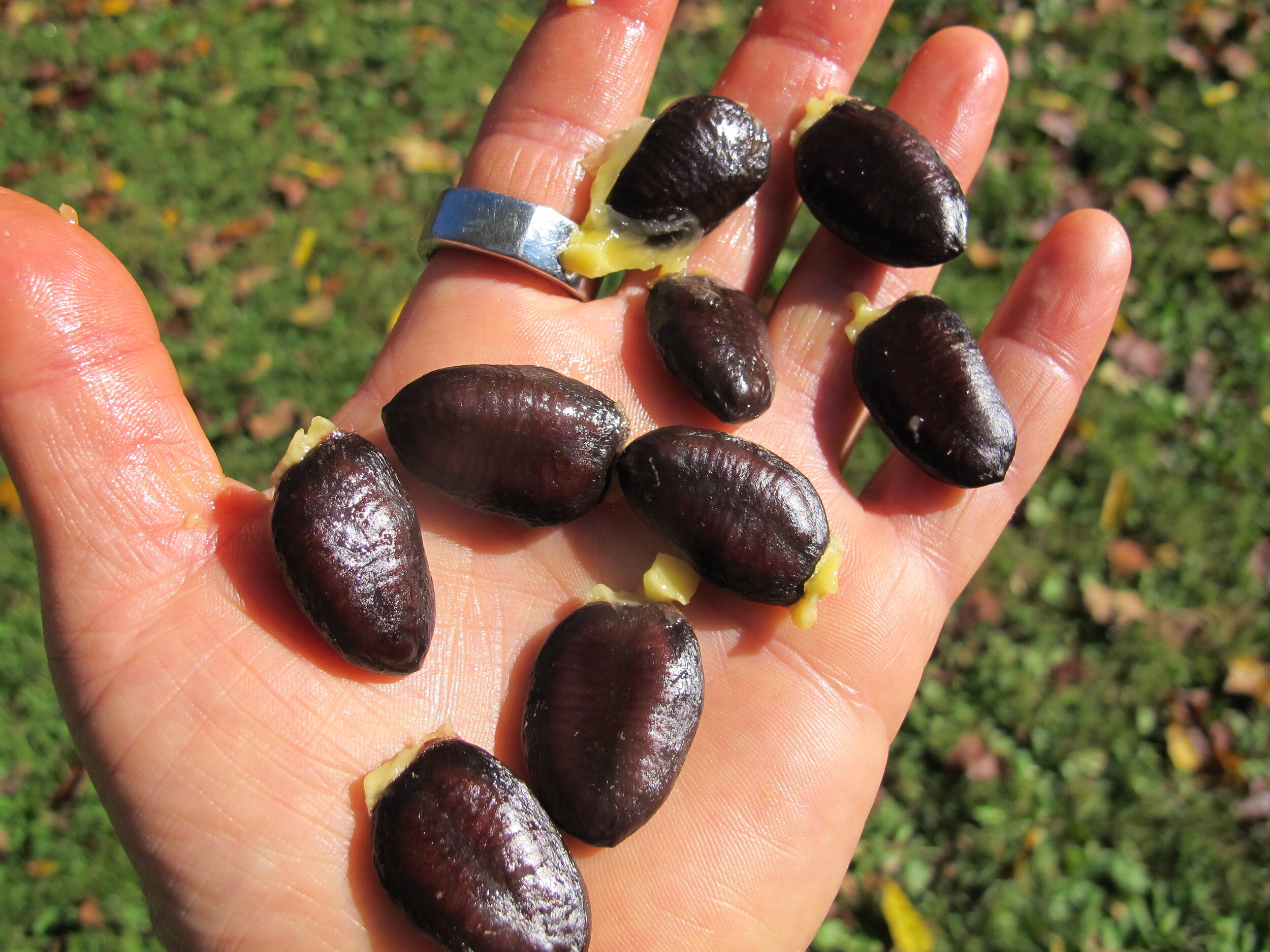Sweetening the air and our tongues with their alluring aroma & flavor, pawpaw fruits are ripening and falling from the trees. This native American treasure, scientifically called Asimina triloba of the Annonaceae family, is a close cousin of custard apple (Annona reticulata), cherimoya (A. cherimola), and guanabana (aka soursop [A. muricata]) and shares their divine taste — somewhat like a banana, peach, melon combo with a hint of vanilla — and custard like texture.
Todays pawpaw harvest ripe and ready for eating. Note the green mesh fabric that covers this basket. This is an attempt to keep fruit flies down which seem to love pawpaws too.
Pawpaw fruit (Asimina triloba) is ready for eating when it emits a seductive tropical odor and has soft-to-the-touch skin. The color of the skin turns from light green to slightly yellow with a few brown spots when ripe. This is when I prefer to eat them and this is what you see in these photos. Although not my preference, some folks wait until the skin turns a grayish-brown-black before eating.
Impressive pawpaw nutrition! Did you know: 3 oz supplies more than half of our daily iron needs and over a third of our daily magnesium needs. That's a lot of nutrient density for a fruit.
This baby is the biggest of the day and weighs 14 oz.
Inside the pawpaw we see yellow flesh with black seeds. Only flesh / fruit pulp is edible. Remove skin and seeds. Eat flesh raw or cooked.
If you can't find any, I encourage you to introduce this native American tree into your landscape, or extended neighborhood. Pawpaws are native to 26 states. They grow as far north as New York (zone 5) and southern Ontario, as far west as Nebraska and Texas, and south to Florida (zone 8). A most worthy wild food!
Large black seeds just removed from pawpaw fruit can be planted right away. Don’ leave out at room temp for long (plant within a couple of days). Germination decreases very quickly if seeds dry out. See below for more info.
PAWPAW SEED PROPAGATION — Helpful info from Kentucky State University Cooperative Extension Program:
“Pawpaw seed is slow to germinate, but it is not difficult to grow seedlings if certain procedures are followed. Do not allow the seed to freeze or dry out, because this can destroy the immature, dormant embryo. If seeds are dried for 3 days at room temperature, the germination percentage can drop to less than 20%. To break dormancy, the seed must receive a period of cold, moist stratification for 70-100 days. This may be accomplished by sowing the seed late in the fall and letting it overwinter; the seed will germinate the following year in late July to late August. Another way is to stratify the seed in the refrigerator (32o- 40o F/0o- 4o C). In this case the cleaned seed should be stored in a plastic ziplock bag with a little moist sphagnum moss to keep the seed moist and suppress fungal and bacterial growth. After stratification the seed should be sown 1 inch (2.5 cm) deep in a well-aerated soil mix, pH 5.5-7, with an optimum temperature of 75o- 85oF (24o- 29o C). Use tall containers, such as tree pots (ht. 14"-18"/35-45 cm) or root trainers (ht. 10"/25 cm), to accommodate the long taproot. The seed will normally germinate in 2-3 weeks, and the shoot will emerge in about 2 months. Germination is hypogeal: the shoot emerges without any cotyledons. For the first two years, growth is slow as the root system establishes itself, but thereafter it accelerates. Trees normally begin to bear fruit when the saplings reach 6 feet, which usually requires five to eight years.” For more cultivation info from KSU, check here: https://kysu.edu/academics/cafsss/pawpaw/
QUICK PAWPAW CHOCOLATE PUDDING: Serves 3
Puree 8 oz pawpaw flesh (skin and seeds removed) with 2 oz heavy cream or coconut milk (btw, if you like you can stop and eat now, the recipe at this stage is delectable pawpaw cream; but to create PCP, continue). In a double boiler or hot water bath, gently heat until just melted 1 oz coconut oil and 1 oz 85% chocolate bar or chip (use 70% for sweeter pudding). Drizzle as you puree this into the pawpaw cream mixture. Eat right away or chill to thicken. Pudding can also be used as a rich yet delicate cake filling or frosting. Equipment: I use a hand held immersion blender and wide mouth glass jar to make this.
PAWPAW CHOCOLATE PUDDING!
Who is eating pawpaws out there, and are you eating them out of hand, or prepping them in some way? Please share your pawpaw recipes!
For an interesting listen check this podcast: Pick A Pawpaw: America’s Forgotten Fruit
Interview of Neal Peterson, primary player in modern pawpaw breeding: Neal’s Story Podcast
Neal Peterson’s website: https://www.petersonpawpaws.com/
For pawpaw fresh frozen fruit pulp check Integration Acres in Ohio. https://www.integrationacres.com/
More pawpaw seed propagation and source info:
www.Biodiverseseed.com [http://www.biodiverseed.com/tagged/paw%20paw%20project]
www.TheSurvivalGardener.com [http://www.thesurvivalgardener.com/how-to-grow-pawpaws-from-seed/]
www.TreePeony.com [https://www.treepeony.com/pages/growing-pawpaw-asimina-triloba-from-seed https://thefruitnut.com/processing-pawpaws-for-seed/]





